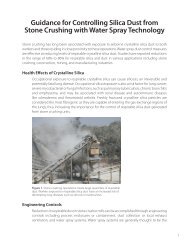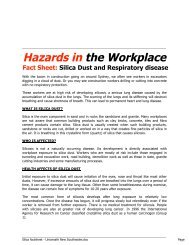Safety & Health in the Stone Crushing Industry - Occupational ...
Safety & Health in the Stone Crushing Industry - Occupational ...
Safety & Health in the Stone Crushing Industry - Occupational ...
Create successful ePaper yourself
Turn your PDF publications into a flip-book with our unique Google optimized e-Paper software.
8<br />
Introduction<br />
<strong>Stone</strong> crush<strong>in</strong>g is necessary <strong>in</strong> order to build roads, bridges, build<strong>in</strong>gs and almost everyth<strong>in</strong>g we need<br />
<strong>in</strong> our modern life. There are an estimated 12000 stone crush<strong>in</strong>g units with about 500.000 workers <strong>in</strong><br />
India. One can presume that several million workers are work<strong>in</strong>g <strong>in</strong> stone crush<strong>in</strong>g all over Asia.<br />
<strong>Stone</strong> crush<strong>in</strong>g provides <strong>in</strong>come for families but <strong>the</strong> work<strong>in</strong>g conditions of employees are often<br />
unhealthy and dangerous. Major concerns <strong>in</strong> stone crush<strong>in</strong>g are accidents and <strong>in</strong>juries, hear<strong>in</strong>g loss,<br />
dust-related lung diseases. All of <strong>the</strong>se diseases can be prevented, <strong>the</strong> work<strong>in</strong>g conditions can be<br />
improved with simple means and m<strong>in</strong>imal cost.<br />
The purpose of this manual is to provide <strong>in</strong>formation and guidance to improve work<strong>in</strong>g conditions and<br />
safety <strong>in</strong> stone crush<strong>in</strong>g units for owners, workers, governmental and non-governmental <strong>in</strong>stitutions,<br />
trade unions and <strong>in</strong>terested persons. It will help stone crush<strong>in</strong>g unit owners to improve <strong>the</strong>ir bus<strong>in</strong>ess<br />
by avoid<strong>in</strong>g unnecessary cost.<br />
The above-mentioned research and development project was funded by The International<br />
Development Research Centre (IDRC), Canada and <strong>in</strong>cluded a thorough assessment of <strong>the</strong> situation,<br />
specifically <strong>the</strong> safety situation <strong>in</strong> stone crush<strong>in</strong>g units and <strong>the</strong> work<strong>in</strong>g conditions. It used observations,<br />
walk-throughs, discussions with owners and workers as well as measurements of dust and noise levels<br />
to analyze <strong>the</strong> situation. F<strong>in</strong>d<strong>in</strong>gs were documented with checklists, photos and data sheets.<br />
Based on <strong>the</strong>se f<strong>in</strong>d<strong>in</strong>gs, recommendations for immediate and low-cost solutions were formulated.<br />
Long-term, sometimes more costly <strong>in</strong>terventions were added. The project team presented All solutions<br />
to <strong>the</strong> unit owners and discussed <strong>the</strong>ir feasibility with <strong>the</strong>m.<br />
Part A " <strong>Safety</strong> & <strong>Health</strong> <strong>in</strong> <strong>the</strong> <strong>Stone</strong> Crush<strong>in</strong>g <strong>Industry</strong>" we look at solutions to prevent accidents<br />
and to keep workers and <strong>the</strong>ir families healthy. The last section discusses <strong>the</strong> elements of emergency<br />
preparedness for <strong>the</strong> <strong>in</strong>dustry.<br />
Part B "Improv<strong>in</strong>g heavy physical work" describes long-term effects of heavy physical work and<br />
suggests solutions to reduce fatigue and prevent illness.<br />
Part C "How Much Does an Accident Cost?" <strong>in</strong>troduces a short and simple table to calculate, better:<br />
estimate, <strong>the</strong> real cost of an accident. It should help to keep <strong>the</strong> right perspective on <strong>the</strong> f<strong>in</strong>ancial side<br />
of accidents and <strong>the</strong> monetary benefits of prevention.<br />
In Part D " Checklists and Benchmarks", we added checklists to make it easier to assess <strong>the</strong><br />
work<strong>in</strong>g conditions. They help <strong>in</strong> analyz<strong>in</strong>g a situation and <strong>in</strong> f<strong>in</strong>d<strong>in</strong>g <strong>the</strong> appropriate measures to<br />
improve. These checklists can be used as benchmarks to document and compare <strong>the</strong> level of <strong>the</strong><br />
safety and health performance of a company. Over time, progress and improvements can <strong>the</strong>n be<br />
documented and experiences shared.<br />
On <strong>the</strong> long run, we hope that such a "safety performance score" for crush<strong>in</strong>g units helps <strong>in</strong> achiev<strong>in</strong>g<br />
better safety performances <strong>in</strong> <strong>the</strong> <strong>in</strong>dustry. We hope that <strong>in</strong> <strong>the</strong> future such a "score" will be <strong>in</strong>cluded <strong>in</strong><br />
tender processes as one of several selection criteria so that <strong>the</strong> order goes to <strong>the</strong> stone crush<strong>in</strong>g units<br />
with <strong>the</strong> best protection for <strong>the</strong>ir workers..







